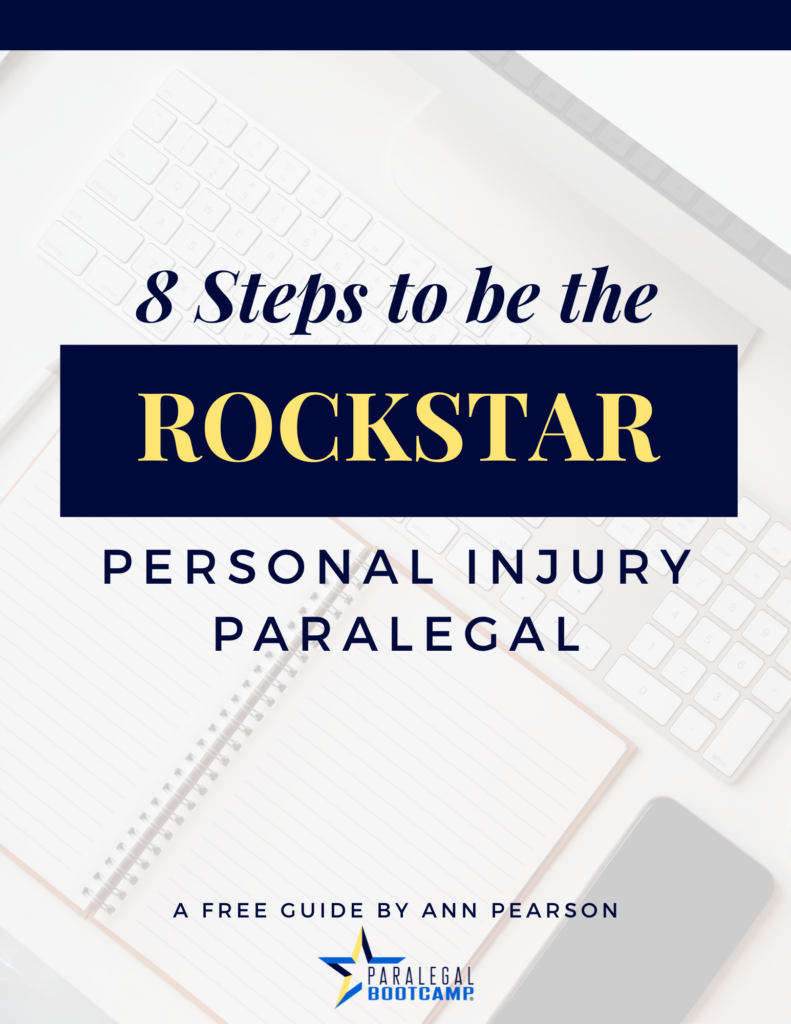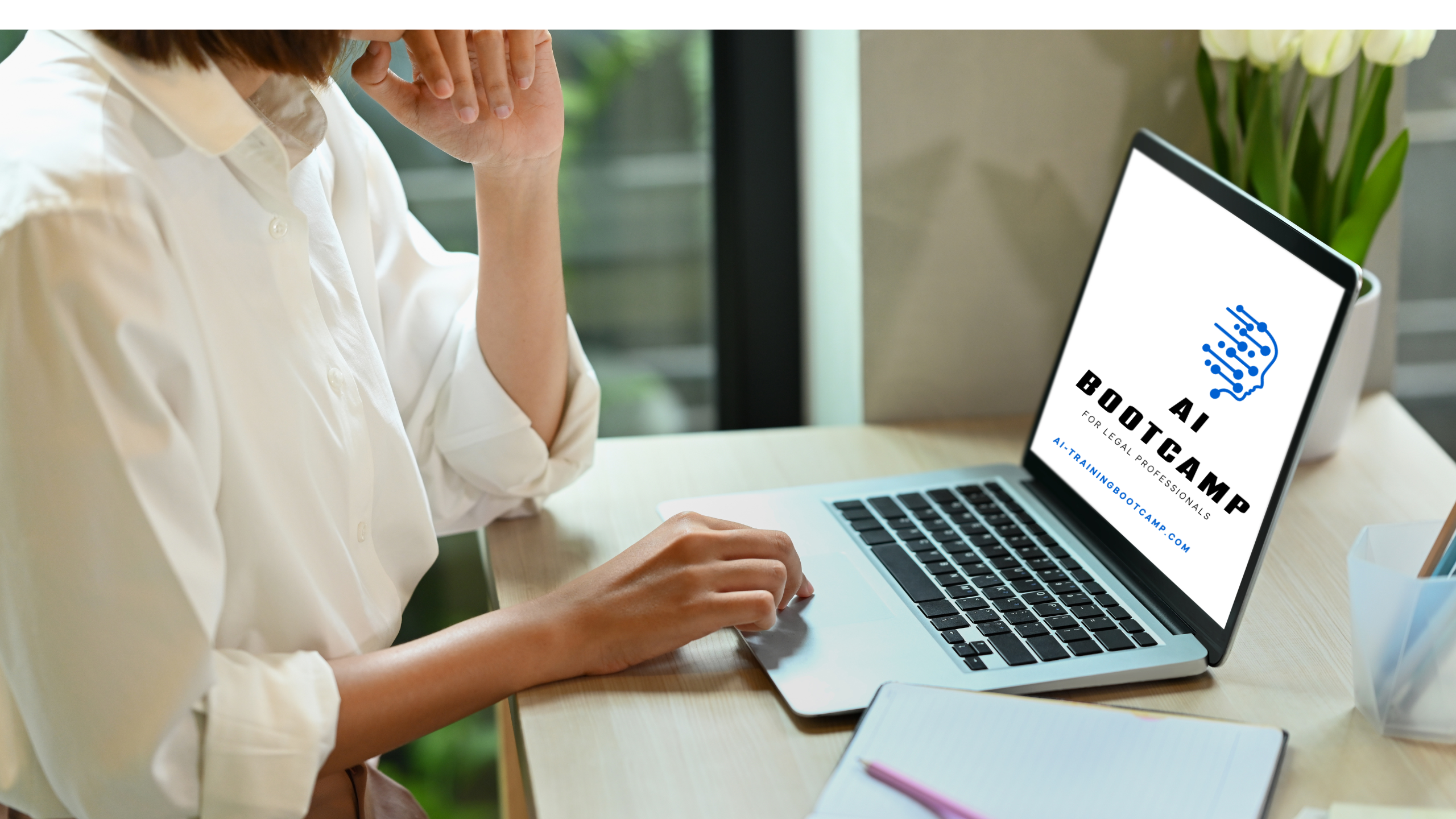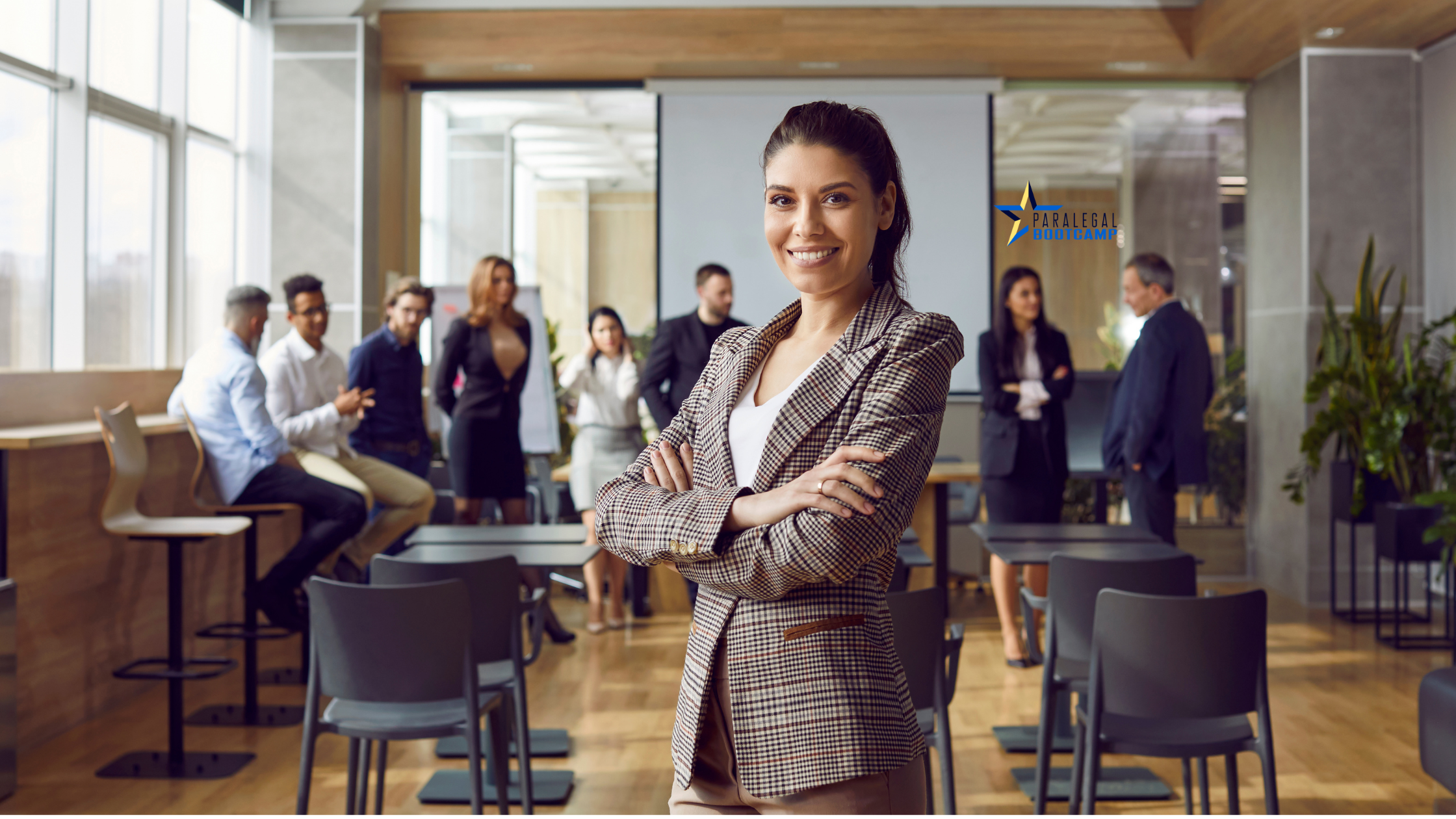We’ve all been there.
Something unexpected happens, and you are asked to jump in at the last minute to help another team get ready for trial on a case you’ve never worked on before.
Or you take over a case from a former paralegal who is no longer at the firm – and you are now the lead paralegal on a case that is going to trial next month and you have never worked on the case before today.
Trial prep can be a stressful period. Whether you are a new litigation paralegal or an experienced paralegal who is new to the case, this will give you a roadmap for navigating the path to success and get up to speed on the case while preparing the trial binder at the same time.
If you are a new paralegal or exploring a paralegal career, start here first and understand what is a litigation paralegal.
If want to just download the PDF and read it on your own, you can do that too.
Get the Ultimate Guide to Preparing a Trial Notebook
Download the Guide and get a trial notebook sample to start preparing your Trial Notebook (a/k/a Trial Binder!) early in the case instead of waiting until you receive the Notice of Trial.
The Trial Notebook
The best method for creating a Trial Notebook and organizing the contents of it is to follow the natural progression of the trial. As you work on each section, you will get up to speed on the case and get ready for trial at the same time.
SECTION I: Reference
This basic reference section will allow you to get familiar with the factual and legal issues of the case as well as the important players on each side’s legal team. It will also serve as a reminder that you need to check on war room capabilities and make a site visit to the courtroom so that you can prepare how you will be setting up your workspace in the courtroom. The essential elements for the Reference section include:
- Table of contents
- Contact List – names, phone, emails for all
- Judge, Clerks, Bailiff, etc.
- Own staff at trial: attorneys, paralegals, others
- Others at trial: client, witnesses, experts, technology person, etc.
- Opposing counsel and staff
- Travel Information, if applicable (war room, courtroom directions, hotel info)
- Case Summary: factual and legal issues
- Proof chart: elements and proof in case
🌟 Paralegal Pro Tip 🌟
Each section of this Trial Notebook can be its own binder so that each notebook is easier to handle. Label the spines numerically by section and place the notebooks in boxes with the spines facing up.
This is assuming that you’re preparing it as a Trial Binder in 3-ring notebooks for the trial team to have in paper form. All of the tips discussed here can also be used in Adobe or another tool so that your trial binder is available electronically.

SECTION II: Pleadings, Discovery, and Pretrial
While you are assembling this section, instead of just gathering the pleadings and discovery and putting them into the notebooks, you can be identifying and extracting key names into a Players List and key dates into a Case Chronology.
This is one of the many things I teach inside the Litigation Paralegal Boot Camp to help paralegals become proactive case managers.
The essential elements for the Pleadings, Discovery, and Pretrial section include:
Major pleadings
-
- Complaint
- Answer
- Counterclaim, Response
Significant discovery responses
-
- Request for admissions
- Interrogatories
- Orders on discovery motions
Major Orders
-
- Scheduling Order
- Pretrial Order
- Order on Motion for Summary Judgment
- Other significant Orders
Take Your Trial Prep to the Next Level
Trial Prep Boot Camp
Getting ready for trial is stressful and rewarding at the same time.
What if your next trial didn’t involve 14-hour work days?
We’ll show you to be so prepared for your next trial that you will actually enjoy going to trial…even if you work for the Master of Procrastination!

SECTION III: Pending Motions
Most of the pending motions relate to evidence that each side wants to keep in or keep out of trial. Because of this, you can get up to speed on the issues of the case and the evidentiary issues easily while preparing this section of your trial notebook.
SECTION IV: Voir Dire
When you first assemble this section, most of the content will be blank because you will not have any information about the jurors.
The function of this section is to make it easy for you to quickly handwrite information about each juror during the jury selection process.
The “Outline of Voir Dire Questions” will give you an idea of what the attorney is looking for in an ideal juror, but you will want to discuss this section with the attorney further so that you know what some of the more important qualities are that they will be looking for when seating the jury.
Use that information to make blank Juror Profile sheets that contain boxes to check off or blank lines to easily answer if each juror has those qualities.
- Jury Challenge Chart
- Juror Profiles
- Outline of Voir Dire Questions
- List of grounds and authority for challenges for cause
- Jury panel chart (blank copies for note-taking)
- Notes section
🌟 Paralegal Pro Tip 🌟
You want to make it as easy as possible to take notes on each potential juror during voir dire. One way you can do that is by having a jury panel chart that coincides with the seats they are sitting in. You can use this for the notes as you start the initial voir dire.

Free Guide for
Personal Injury Paralegals
Are you ready to be a rockstar personal injury paralegal?
When you’re starting out, it’s hard to know where to even start. We’ve got you covered! Here is your checklist.
The Paralegal Boot Camp gives you 8 actionable steps to get you started right now on a path to success.
Our free guide shares the 8 steps you need to take right now to start standing out at your firm.
SECTION V: Opening Statement
The opening statement is one the most comprehensive place to start if you want to quickly learn what the case is about because the attorney is essentially outlining everything she wants to prove at trial. The opening statement is the equivalent of the compass for the trial.
- Outline of opening statement
- The complete text of opening statement
- Printed slides/list of charts
🌟 Paralegal Pro Tip 🌟
If the attorney is planning to use PowerPoint slides during the opening statement, be sure that you have tested how the slides look when they are displayed on the technology that is in the courtroom. Some of the new widescreen templates and colors in PowerPoint do not display the same when using different projectors.
SECTION VI: Outline of Order of Proof and of Opponent’s Proof
This section is the “road map” for trial. The Outline of Order of Proof maps out how the trial will progress, what order the attorney expects to call the witnesses and what order they expect to introduce the evidence. It is useful for an attorney to do this because they can see if there are any gaps in how a piece of evidence will get introduced. Thus, this section is a great way for a paralegal to get up to speed fast as it maps out the entire trial chronologically.
SECTION VII: Witness Examination
As you are preparing the list of exhibits to be introduced, you can update your Working Exhibit List with the name of the witness that the exhibit will be introduced through while they are on the witness stand. This allows you to become familiar with the exhibits and each of the witnesses.
- Your Witnesses (in alphabetic order).
- Their Witnesses
SECTION VIII: Exhibits
Drafting the Trial Exhibit List will allow you to become familiar with the documents that will be presented as trial exhibits. You will have your hands on all of the exhibits at least three times: (1) when drafting the exhibit list; (2) when you are putting together the exhibit notebooks and exchanging with opposing counsel; and (3) when you are assembling the witness notebooks.
- Trial Exhibit List (the abbreviated version that gets exchanged with other side)
- Full Working Exhibit List (detailed version for internal use only)
- Each exhibit in numeric order (if voluminous, refer to box)
- List of audio/visual/demonstrative exhibits
🌟 Paralegal Pro Tip 🌟
If you are not exporting your draft exhibit list as a report from a document database, then use Microsoft Excel for your Working Exhibit List. With Excel, you will be able to filter your columns to quickly find exhibits.
SECTION IX: Trial Motions and Authorities
Trial motions are different than the section on pending motions.
Trial motions relate specifically to things that the attorney anticipates happening during the trial. For example, if it is a jury trial, there might be a Motion for Judgment Notwithstanding the Verdict or some other action that each party is asking the judge to take.
- Any trial motions (directed verdict, dismissal, etc.) with the responses, reply, and sur-reply.
- Authorities for all motions are organized alphabetically by citation.
SECTION XII: Closing Statement
This section is a work in progress that changes throughout trial, depending on what happens throughout the trial. The closing statement preparation starts with the Outline of Order of Proof and is supplemented with information that you can obtain through the trial notes and the detailed information you have added to your Working Exhibit List. For example, the attorney will want to be able to reference “exhibit 236 introduced through witness Doe.”
- Outline of closing statement (and/or full text at closing)
- Props or list of props
- Notes section for recording items to be added as trial progresses
SECTION X: Jury Instructions
The jury instructions are what the judge reads to the jury before they deliberate. Each side submits their proposed instructions and the judge rules on the exact language that will be used when the judge instructs the jury on how the law applies to the case and the evidence they heard throughout the trial.
- The attorney’s copy of all instructions proposed to be read to the jury, along with the opposition’s proposed instructions.
- Final copy of instructions that will be read by Judge.
- If no jury, copy of Request for Findings of Fact and Conclusions of Law.
🌟 Paralegal Pro Tip 🌟
Each instruction should contain complete language of instructions, one instruction per page, plus any legal authorities supporting its use. Each instruction page should contain a check-off for given, modified, or refused. Have enough copies for all parties, the judge and the clerk).
SECTION XI: Proposed Verdict Form
Unlike the jury instructions that are read aloud to the jury before they go back to deliberate, the proposed verdict forms are something that goes into the jury deliberation room. A verdict form identifies the burden of proof that is necessary for the jury to rule on each allegation and is usually a combination of what each side proposes.
- Verdict Form
- Supporting Authorities
SECTION XIII: Law Section
Think of this section as your legal research section, not on particular issues like the pending motions but rather on general legal issues and the rules.
- Trial Memo or brief covering the law on all significant questions of law
- Notes from Judge’s Bench Book
- Pertinent Rules of Evidence and Rules of Procedures (but also bring books to courtroom)
.
SECTION XIV: Notes, Reminders, To-Do
This is your section to use for your reminders and notes taken throughout the trial. Be sure to check this section before the trial gets to the closing statements in case there are notes on things that need to be done related to the evidence.
- To-Do List
- Reminders of motions to make, whether to poll the jury, etc.
- Notes section for items that come up, notes for appeal, and others.
Keep Learning
Ask any trial paralegal who has experienced the last-minute rush to prepare for trial, and they will all tell you that as challenging as it is, it is also very rewarding.
Every time you attend a trial, you learn a little more and become a better trial paralegal.
If you want to reduce that learning curve and jumpstart your trial prep training with tons of resources and downloads, get started immediately with our Trial Prep Boot Camp.
Take Your Trial Prep to the Next Level
Trial Prep Boot Camp
Getting ready for trial is stressful and rewarding at the same time.
What if your next trial didn’t involve 14-hour work days?
We’ll show you to be so prepared for your next trial that you will actually enjoy going to trial…even if you work for the Master of Procrastination!

Meet the Author

Ann Pearson is the Founder of the Paralegal Boot Camp, and host of the Paralegals on Fire! Podcast Show, and passionate about promoting the paralegal profession.
Ann spent 20 years working as a paralegal manager and a litigation paralegal before opening the Paralegal Boot Camp in 2010.
Ann’s training programs focus on adding immediate value to a paralegal’s career and bridging the gap between what a paralegal learns in school and what they actually do on the job.
Visit the About Us Page to learn more about why Ann started the Paralegal Boot Camp.


























